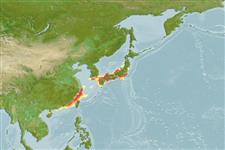Klassifizierung / Names
Namen | Synonyme | Catalog of Fishes(Gattung, Arten) | ITIS | CoL | WoRMS | Cloffa
Environment: milieu / climate zone / depth range / distribution range
Ökologie
seewasser demersal; tiefenbereich 60 - 123 m (Ref. 75057). Subtropical
Northwest Pacific: China and Japan (Ref. 75057).
Size / Gewicht / Alter
Maturity: Lm ? range ? - ? cm
Max length : 4.0 cm SL Männchen/unbestimmt; (Ref. 75057)
Kurzbeschreibung
Morphologie | Morphometrie
Rückenflossenstacheln (insgesamt): 7; Rückenflossenweichstrahlen (insgesamt): 112; Afterflossenstacheln 1; Afterflossenweichstrahlen: 11. This species is distinguished from its congeners by the following set of characters: 11-12 (usually 11) segmented rays on second dorsal fin; 26-27 (-30?) longitudinal scale count; predorsal scales absent; 8 transverse scales from origin of second dorsal fin backward and downward to anal-fin base; pectoral-fin base naked; anterior 3 spines of first dorsal fin usually elongate and filamentous, extending posteriorly to base of first, second or third segmented ray of second dorsal fin; connecting membrane between innermost rays well developed; when fresh: irregular shaped yellow (pale in preservative) markings on cheek and operculum, oblique narrow yellow line from posterior end of eye to nape, small bright yellowish red spot on center or anteroventral part of operculum, ca. 9 narrow yellow vertical bars on body, distal tip of first dorsal fin vivid red, and a narrow yellow longitudinal band on middle of anal fin (Ref. 75057).
Life cycle and mating behavior
Geschlechtsreife | Fortpflanzung | Ablaichen | Eier | Fecundity | Larven
Eschmeyer, W.N. (ed.), 2006. Catalog of fishes. Updated database version of April 2006. Catalog databases as made available to FishBase in April 2006. (Ref. 56787)
IUCN Rote Liste Status (Ref. 130435)
Bedrohung für Menschen
Harmless
Nutzung durch Menschen
Mehr Information
NamenSynonymeMetabolismusRäuberÖkotoxikologieFortpflanzungGeschlechtsreifeAblaichenSpawning aggregationFecundityEierEientwicklung
Alter/GrößeWachstumLänge-GewichtLänge-LängeLängenhäufigkeitenMorphometrieMorphologieLarvenLarven Pop.Dyn.RekrutierungDichteBRUVS
ReferenzenAquakulturAquakultur ProfilZuchtlinienGenetikElectrophoresesVererbbarkeitKrankheitenVerarbeitungNutrientsMass conversion
PartnerBilderStamps, Coins Misc.LauteCiguateraGeschwindigkeitSchwimmstilKiemenoberflächeOtolithsGehirngrößeSehfähigkeit
Tools
Zusatzinformationen
Download XML
Internet Quellen
Estimates based on models
Phylogenetic diversity index (Ref.
82804): PD
50 = 0.5000 [Uniqueness, from 0.5 = low to 2.0 = high].
Bayesian length-weight: a=0.00912 (0.00295 - 0.02818), b=2.98 (2.72 - 3.24), in cm total length, based on LWR estimates for this (Sub)family-body shape (Ref.
93245).
Trophic level (Ref.
69278): 3.2 ±0.3 se; based on size and trophs of closest relatives
Widerstandsfähigkeit (Ref.
120179): hoch, Verdopplung der Population dauert weniger als 15 Monate. (Preliminary K or Fecundity.).
Fishing Vulnerability (Ref.
59153): Low vulnerability (10 of 100).
